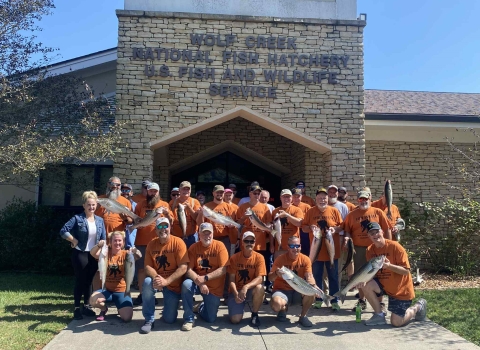Two public hearings will be held during the comment period. The hearings are scheduled for 7:00 to 9:00 p.m. at the Community Center of Reserve, New Mexico, on Wednesday, March 1, and at Light Hall, Western New Mexico University in Silver City on Thursday, March 2, 2000.
An interdisciplinary team comprised of Fish and Wildlife Service and Forest Service personnel recently reviewed the Services proposal to build low impact temporary holding pens at up to four sites within the Gila Wilderness. The pens would hold recaptured wolves slated for translocation for management purposes. The Service will take the lead in implementing the National Environmental Policy Act (NEPA) process regarding translocation. The Service completed an Environmental Impact Statement in 1996 that addresses the effects of reintroducing wolves into the Blue Range Wolf Recovery Area (BRWRA). The approved action allows for the direct release of wolves into the primary recovery zone in Arizona, and for dispersal and active management of wolves throughout the area which includes all of the Apache-Sitgreaves and Gila National Forests in Arizona and New Mexico. The Service has the authority through the Experimental Population Rule for the reintroduced population to translocate wolves for management purposes from the primary wolf recovery zone in the Apache National Forest in east-central Arizona to any location within the Blue Range Wolf Recovery Area. The purpose of the EA is to determine whether there are any significant effects associated with the proposed translocation that were not addressed in the original EIS, or any significant changes in the project that would warrant the preparation of a supplemental EIS.
"Our objective in translocating wolves is to maximize the potential of reintroduced animals to succeed, and to minimize the impacts of wolves on human uses of the same landscapes, such as livestock grazing and recreation" said Nancy Kaufman, Regional Director. Wendy Brown, Mexican Wolf Biologist for the Service added, "The four sites that we have proposed to use within the Gila Wilderness were identified because they are remotely located, have good game populations, and are not grazed by livestock."
The Fish and Wildlife Service is the principal Federal agency responsible for conserving, protecting, and enhancing fish and wildlife and their habitats for the continuing benefit of the American people. The Service manages the 93-million-acre National Wildlife Refuge System comprised of more than 500 national wildlife refuges, thousands of small wetlands, and other special management areas. It also operates 66 national fish hatcheries and 78 ecological services field stations. The agency enforces Federal wildlife laws, administers the Endangered Species Act, manages migratory bird populations, restores nationally significant fisheries, conserves and restores wildlife habitat such as wetlands, and helps foreign governments with their conservation efforts.



